How to Cite | Publication History | PlumX Article Matrix
Comparative Studies of Fungal Degradation of Bioaccessible Reactive Azo Dyes
K. Haritha and K. R. S Sambasiva Rao
Centre for Biotechnology, Acharya Nagarjuna University, Guntur - 522 510 India.
ABSTRACT:
Azodyes are important chemical pollutants of industrial origin. The decolourisation and degradation efficiency of Aspergillus niger and Phanerochaete chrysosporium RP-78 with the reactive azodyes- Procion Brilliant Red H-E7B (Reactive Red 141), Procion Yellow H-E4 (Reactive yellow 84), Procion Navy Blue H-ER (Reactive blue 171) was studied. Among the three azodyes, Procion navy blue is the rapidly degrading one followed by Procion brilliant red and Procion yellow. The present studies also indicate that P. chrysosporium RP-78 is the best bio-remediative organism than A. niger. Though A. niger shows less ability than P. chrysosporium RP-78, it has showed appreciable ability of degradation. It was observed that the inducer (Veratryl alcohol) and inhibitor (Thiourea) of lignin degradation significantly affected the dye degradation.
KEYWORDS: Reactive azodyes; degradation; textile industry; bioremediation
Download this article as:| Copy the following to cite this article: Haritha. K, Sambasiva Rao. K. R. S. Comparative Studies of Fungal Degradation of Bioaccessible Reactive Azo Dyes. Biosci Biotechnol Res Asia 2009;6(2) |
| Copy the following to cite this URL: Haritha. K, Sambasiva Rao. K. R. S. Comparative Studies of Fungal Degradation of Bioaccessible Reactive Azo Dyes. Biosci Biotechnol Res Asia 2009;6(2). Biosci Biotechnol Res Asia 2009;6(2). Available from: https://www.biotech-asia.org/?p=9111. |
Introduction
Azo dyes are released in large quantities into the environment from textile industries. These dyes are recalcitrant to microbial degradation, causing innumerable problems in routine biological treatment of the industrial effluents1, 2, and 3. Despite this, microbial degradation of azodyes has been well reported using different microorganisms4, bacteria5, yeast6 and filamentous fungi, such as the white rot fungi7, 8. Due to the fungi oxidative mechanisms it is possible to avoid the formation of hazardous anilines, formed by reductive cleavage of the azodyes, by other microorganisms such as bacteria9, 10, and 11. The white rot fungi produce several enzymes that have been related to their ability to degrade natural polymers, such as lignin and cellulose, and it was construed that they can degrade various synthetic chemicals, usually recalcitrant to biodegradation12. One of the well-characterized white rot fungi for industrial use is the basidiomycete P. chrysosporium RP-78. The interest in this fungus is mainly due to the expression of some non-specific extracellular enzymes, as the ligninolytic peroxidases, that have been implicated in the degradation of dyes13, 14. In the present study, an attempt has been made to assess the potential and ability of two fungi (P. chrysosporium RP-78 and A. niger) on the biodegradation of fungal bioaccessible reactive azo dyes. This constitutes an approach for a good strategy of environmental protection, thinking of working out the possibility for fungal wastewater treatment in textile industries.
Materials and Methods
Maintenance of organisms
The Phanerochaete crysosporium RP-78 was obtained from the Forest products laboratory, Madison, WI, USA and the culture of A. niger was procured from Institute of Microbial Type Culture Collection, Chandigarh, India. The pure cultures of Phanerochete crysosporium RP-78 and A. niger were maintained in YMPG and PDA medium respectively in laboratory by serial subculturing for every 15 days and stored at 40C.
Dyes
The dyes selected for decolourisation studies were procion dyes, which were procured from Atul Dyes Manufacturing Limited, Gujarat, India. The selected procion dyes are usually known as reactive azo dyes. In a reactive dye, a chromophore will be present that contains a substituent which will be activated and allowed directly to react with the surface of the substrate.Procion Brilliant Red H-E7B (Reactive Red 141), Procion Yellow H-E4 (Reactive yellow 84), Procion Navy Blue H-ER (Reactive blue 171).
Apparatus used
Elico SL 159 Spectrophotometer, Scigenic Biotech Orbital Shaker, Ohaus Adventure weighing balance, NSW 151 Incubator, Elico pH meter, NSW 151 Hot air oven, Kemi Laminar air flow, and Sigma 3K 30 High Speed centrifuge.
Medium composition
In the present study, the modified and optimized YMPG medium containing 1% Glucose, 0.6% Aspargine, 0.2% MgSO47H2O and 0.5% KH2PO4, pH-4.5 was used for the degradation studies.
Methodology
The experimental procedure for dye decolourization was followed as per the method described by Colleen Cripps15. The modified and optimized YMPG was inoculated with 2% overnight developed seed culture of P. crysosporium RP-78 and Aspergillus niger. The culture was allowed to grow for 6 days at 200 rpm and on the sixth day the dye was added to the medium. The rate of degradation was studied by decrease in the absorbance (at lmax 408 nm) of the samples collected by centrifuging the broth at 10000 rpm for 15 minutes at different time intervals during the course of experiment. The concentration of the dye was calculated from the standard graph and the percentage of degradation of dye was estimated using the following formula

Effect of Thiourea on Dye degradation
The effect of thiourea, an inhibitor on degradation of dyes was studied by adding 5 mM thiourea to the degradation media. The urea (5 mM) was used as a control, which was not an inhibitor. The degradation rate was studied following the procedure detailed earlier. The biodegradation of the azodyes was monitored by UV-Vis analysis.
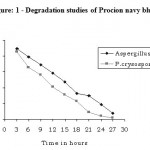 |
Figure 1: Degradation studies of Procion navy blue.
|
Effect of Veratryl alcohol (VA) on Degradation
The effect of inducer Veratryl alcohol 3, 4-dimethoxy benzyl alcohol) on fungal decolourisation was studied by adding 0.125 g to 100 ml of the degradation medium. The medium was inoculated and allowed to grow for 6 days. On the sixth day dye was added. Then the rate of degradation of the dye in that medium was determined as per the procedure mentioned above.
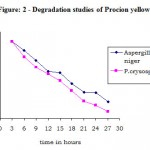 |
Figure 2: Degradation studies of Procion yellow.
|
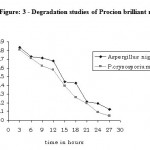 |
Figure 3: Degradation studies of Procion brilliant red.
|
Results and Discussions
The UV spectrum showed dramatic changes in different sample solutions. The decrease in the intensity of the visible peak was very rapid and indicates complete decolourisation with the disruption of the chromophore group. The decrease in the absorbance in the two peaks in UV region (242 and 307 nm) suggests that there were changes in the aromatic group. The absorption maximum (λmax) of procion navy blue, procion yellow and procion brilliant red was observed to be 610 nm, 408 nm and 543 nm respectively. For biodegradation studies, and to determine the ability of A. niger and P. crysosporium RP-78 in decolorizing the selected dyes, the experiments were performed for a period one month. The results indicate that the ability of A. niger, P. crysosporium was varied in all the experiments, As shown in figures 1-3, most of the colour loss was occurred within 24 hours, however some of the dye remains adsorbed by the mycelia that can be desorbed with methanol after five days. Among the three dyes, the rate of degradation of the procion navy blue was found to be very high followed by brilliant red, nevertheless the procion yellow was not completely degraded by A. niger and P. crysosporium RP-78. In consonance with this, a high decolourization 76% for procion navy blue and 70% for procion brilliant red of 62% for procion yellow was observed with P. crysosporium RP-78. Whereas the percentage of degradation of 69% for procion navy blue, 60% for procion brilliant red 53% for procion yellow, with A. niger was observed. The rate of degradation was more for P. crysosporium RP-78 than A. niger.
Effect of Thiourea on Dye degradation
The effect of lignin degradation inhibitor on dye decolorization was examined. Thiourea, a potent -OH scavenger and inhibitor of lignin degradation, was very effective in inhibiting all the dyes degradation16, but the extent of inhibition was varied from dye to dye. In the presence of thiourea, the percentage of degradation of procion navy blue was decreased by 23% where as the degradation of procion yellow and procion brilliant red was decreased by 16% and 15% respectively. Among the three dyes the degradation of procion navy blue was effected more than the procion yellow and procion brilliant red (Fig. 4). This result was in agreement with the results of Glen and Gold 16.
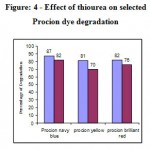 |
Figure4: Effect of thiourea on selected Procion dye degradation.
|
Effect of Veratryl alcohol (VA) on Degradation
Veratryl alcohol (3, 4 dimethoxy benzyl alcohol) is an inducer of the lignin peroxidase 17, 18, 19 and it is involved in the degradation of dyes. In the presence of inducer, the production of the enzyme was more in the presence of the veratryl alcohol and the percentage of degradation was more than the control, but it shows minor effect only as shown in the figure 5. The presence of veratryl alcohol increases the degradation of procion navy blue by 2%. Wheras the degradation of procion yellow and procion brilliant red were increased by 4% and 3% respectively (Fig. 5)
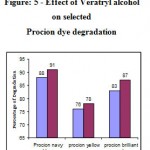 |
Figure 5: Effect of Veratryl alcohol on selected Procion dye degradation.
|
Summary and Conclusion
The procion dyes (reactive Azodyes) were efficiently degraded by A. niger and P. chrysosporium RP-78, but the rate of degradation is varied from dye to dye depending on their structural complexity. Veratryl alcohol a substrate analogue has increased the dye degradation whereas the thiourea decreased the degradation efficiency.
References
- Schoeman, M., D. Dickinson. Growth of Aureobasidium pullulans on lignin breakdown products at weathered wood surfaces. Mycologyst 11: 168–172(1997).
- Swamy, J., J. A. Ramsay. The evaluation of white rot fungi in the decolourisation of textile dyes. Enzyme Microb. Technol. 24: 130–137(1999).
- Abadulla, E., T. Tzanov, S. Costa, K.-H. Robra, A. Cavaco-Paulo, G. M. Geubitz. Decolourisation and detoxification of textile dyes with laccase from Trametes hirsuta. Appl. Environ. Microbiol. 66: 3357-3362(2000).
- McMullan, G., C. Meehan, A. Conneely, N. Kirby, T. Robinson, P. Nigam, I. M. Banat, R. Marchant, W. F. Smyth.. Microbial decolourisation and degradation of textile dyes. Appl. Microbiol. Biotechnol. 56: 81-87(2001).
- Rajaguru, P., K. Kalaiselvi, M. Palanivel, V. Subburam. Biodegradation of azo dyes in a sequential anaerobicaerobic system. Appl. Microbiol. Biotechnol. 54: 268–273(2000).
- Martins, M. A. M., M. H. Cardoso, M. J. Queiroz, M. T. Ramalho, A. M. Oliveira-Campos. Biodegradation of azo dyes by the yeast Candida zeylanoides in batch aerated cultures. Chemosphere 38: 2455–2460(1999).
- Martins, M. A. M., I. C. Ferreira, I. F. M. Santos, M. J. Queiroz, N. Lima.. Biodegradation of bioaccessible textile azo dyes by Phanerochaete chrysosporium. J. Biotechnol. 89: 91-98(2001).
- Pointing, S. B. Feasibility of bioremediation by white-rot fungi. Appl. Microbiol. Biotechnol. 57: 20–33(2001).
- Platt, M.W., Y. Hadar, I. Chet. Fungal activities involved in lignocellulose degradation by Pleurotus. Appl. Environ. Microbiol. 20: 150-154(1984).
- Chung, K.-T., B. Stevens. Degradation of azo dyes by environmental microorganisms and helminthes. Environ. Toxicol. Chem. 12: 2121-2132(1993).
- Thurston, C. F.,.The structure and function of fungal laccases. Microbiology 140: 19–26(1994).
- Field, J.A., E. De Jong, G. Feijoo-Costa, J.A.M. De Bont. Screening for ligninolytic fungi applicable to the biodegradation of xenobiotics. Trends Biotechnol. 11: 44-49(1993).
- Spadaro, J. T., M. H. Gold, V. Renganathan. Degradation of azo dyes by the lignin-degrading fungus Phanerochaete chrysosporium. Appl. Environ. Microbiol. 58: 2397–2401(1992).
- Ollikka, P., K. Alhonmaki, V.-L. Leppanen, I. R. Glumoff, I. Suominnen. Decolorization of azo, triphenyl methane heterocyclic and polymeric dyes by lignin peroxidase isoenzyme from Phanerochaete chrysosporium. Appl. Environ. Microbiol. 59: 4010-4016(1993).
- C Cripps, J A Bumpus and S D Aust. Biodegradation of azo and heterocyclic dyes by Phanerochaete chrysosporium. Appl Environ Microbiol. , 56(4): 1114-1118(1990).
- Glenn, J. K. and M. H. Gold. Decolorization of several polymeric dyes by the lignin-degrading basidiomycete Phanerochaete chrysosporium. J. Appl. Environ. Microbiol. 45:1741-1747(1983).
- Arora D.S. and P. K. Gill. Comparison of two assay procedures for lignin peroxidase. J. Biotechnology Techniques. 10: 273-276(1996).
- Viral, C., S. Rohit, S. Dharmendra, M. Hasmukh and RM V`, Bharatkumar. Mediator role of veratryl alcohol in the lignin peroxidase-catalyzed oxidative decolorization of Remazol brilliant blue R J. Enzyme and Microbial Technology 36: 426-431(2004)
- Palmieri, G, G. Cennamo and G. Sannia. Remazol Brilliant Blue R decolourisation by the fungus Pleurotus ostreatus and its oxidative enzymatic system J. Enzyme and Microbial Technology 36: 17-24(2005).

This work is licensed under a Creative Commons Attribution 4.0 International License.





